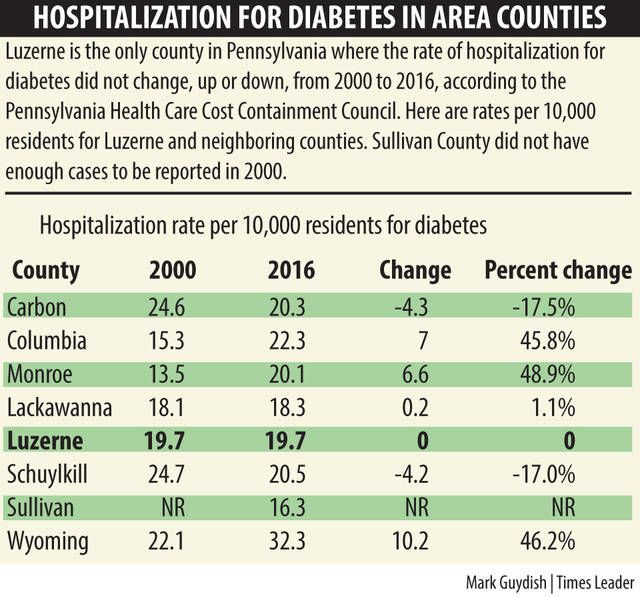Click here to subscribe today or Login.
Luzerne County has the distinction of being the only one of Pennsylvania’s 67 counties where the rate of hospitalization for diabetes has remained unchanged since 2000, according to a new report.
Meanwhile, rates jumped for some neighboring counties — Columbia County saw a 45.8 percent spike — and decreased for others such as Schuylkill County, where rates dropped 17 percent. Carbon County posted a similar percentage reduction.
A project by the Pennsylvania Health Care Cost Containment Council (PHC4) compared the number of hospitalizations for diabetes per 10,000 residents for each county from 2000 and 2016. The data included only admissions for diabetes, not for patients admitted for some other reason who had diabetes. The report notes adding those patients would increase totals dramatically.
Three counties saw the rate inch up by less than 2 percent, including Lackawanna County, where the rate went from 18.1 per 10,000 residents to 18.3, for a 1.1 percent increase. Three other counties had a similar change in the other direction, seeing their rates drop by less than 2 percent.
In 25 counties, the rate increased by 20 percent or better.
But only Luzerne County showed zero change, with 19.7 cases per 10,000 residents in 2000 and in 2016. The number of admissions for diabetes in the county has actually dropped, albeit slightly, from 629 to 623.
The report notes that, statewide, admissions for diabetes increased 13 percent between 2000 and 2016, from 21,528 to 24,283, but the rate has remained fairly steady since peaking at 24,432 since 2008.
The brief also notes admissions for diabetes have shot up 38 percent for those under 45, but decreased 12 percent for those 45 and older. The overall rate for the older group is still higher than for the under 45 group.
As is often pointed out in discussing diabetes, most cases are considered preventable. In 2016, about 86 percent of diabetes admissions for ages 18 and older were considered potentially preventable.





